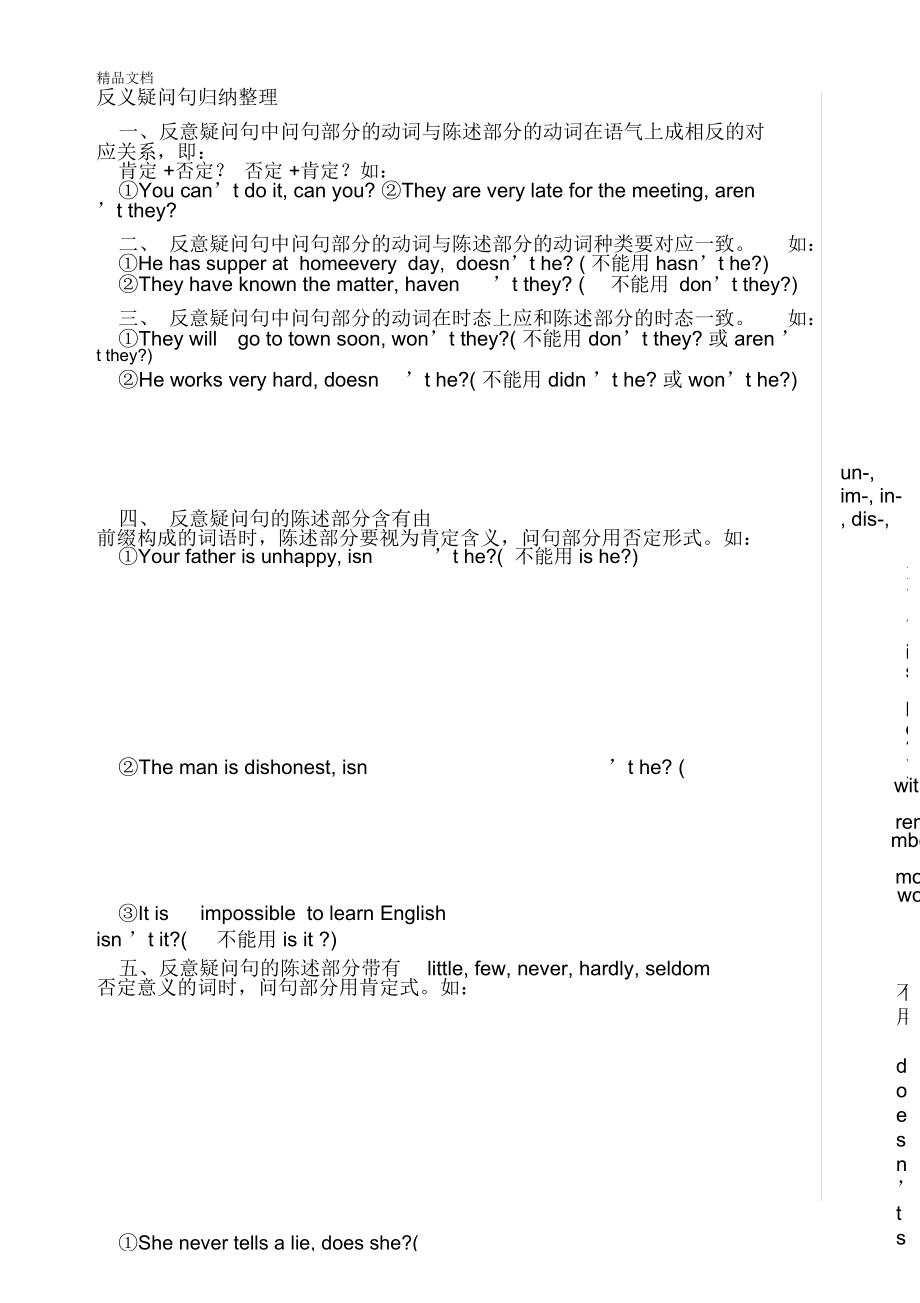 反义疑问句归纳整理教学内容
反义疑问句归纳整理教学内容



《反义疑问句归纳整理教学内容》由会员分享,可在线阅读,更多相关《反义疑问句归纳整理教学内容(6页珍藏版)》请在装配图网上搜索。
1、精品文档反义疑问句归纳整理一、反意疑问句中问句部分的动词与陈述部分的动词在语气上成相反的对应关系,即:肯定 +否定? 否定 +肯定?如:You cant do it, can you? They are very late for the meeting, aren t they?二、 反意疑问句中问句部分的动词与陈述部分的动词种类要对应一致。如:He has supper at homeevery day, doesnt he? ( 不能用 hasnt he?)They have known the matter, havent they? (不能用 dont they?)三、 反意疑问句中
2、问句部分的动词在时态上应和陈述部分的时态一致。如:They willgo to town soon, wont they?( 不能用 dont they? 或 aren t they?)t he?( 不能用 didn t he? 或 wont he?)He works very hard, doesn四、 反意疑问句的陈述部分含有由un-, im-, in-, dis-,等否定意义的前缀构成的词语时,陈述部分要视为肯定含义,问句部分用否定形式。如:Your father is unhappy, isnt he?( 不能用 is he?)The man is dishonest, isnt he
3、? (不能用 is he?)It isimpossible to learn Englishwithout remembering more words,isn t it?(不能用 is it ?)五、反意疑问句的陈述部分带有little, few, never, hardly, seldom等否定意义的词时,问句部分用肯定式。如:不用 doesnt she?)She never tells a lie, does she?(He was seldom late, was he?(不用 wasn t he?)六、反意疑问句的陈述部分为I am 时,问句部分习惯上用arent I ?表示。如:t
4、 I?I am a very honest man, aren七、反意疑问句的陈述部分为I(We) think(believe, suppose, consider)+ that 从句时,问句部分的动词及主语与 that 从句内的动词和主语保持一致。如:I think that he has done his best, hasnt he?we?)We think that English is very useful, isn t it? ( 不用 dont八、反意疑问句的陈述部分为 I(We) don t think(believe, suppose,thatconsider)+ that
5、从句时,从句为否定意义, 问句部分的动词和主语仍与从句保持一致且用肯定式。如:不用 do I?)I don t think that you can do it, can you? (We dont believe that the news is true, is it? (不用 do we?)九、反意疑问句的陈述部分为非第一人称主语+ think(believe, suppose,consider) + that从句时,问句部分的动词和主语与陈述部分的主句动词和主语保持一致。如:t they? (不They all think that English is very important,
6、 don用 isn t it?)think that the news was true,did he? ( 不用 wasnt/wasHe didn tit?)十、反意疑问句的陈述部分为主语 +said( told, reported, asked) +that 从句时,问句部分的动词和主语与陈述部分的主句动词和主语保持一致。如:t they? (They said that you had finished your work, didn不用hadnt you)t she? ( 不用 wouldnKate told you that she would go there, didnt she
7、?)精品文档精品文档十一、陈述部分的主语为不定代词something, anything, nothing,everything 时,问句部分的主语用 it 。如:t it? Something is wrong with the computer, isn Nothing has happened to them, has it?十二、陈述部分的主语为不定代词somebody(someone), anybody(anyone),nobody(no one), everybody(everyone)时,问句部分的主语用he 或 they ,这时问句动词的数应和 he 或 they 一致。如:S
8、omeone has taken the seat, hasnt he?t they?Everyone has done their best in the game, haven十三、陈述部分为 Let me 时,问句部分习惯上用 shall I?或 will you?形式。如:Let me have a try, shall I?(will you?)will you? 形式。如:十四、陈述部分为 Let us 时,问句部分习惯上用Let us stop to rest, will you?shall we? 形式。如:十五、陈述部分为 Let s 时,问句部分习惯上用Let s go h
9、ome together, shall we?十六、陈述部分用上述情况以外的祈使句时,问句部分一般用will you?形式表示请求,用 wont you ?形式表示委婉请求或邀请。如:Do sit down, won t you?/ will you?t you?)Please open the window, will you?(won十七、陈述部分为否定祈使句时,问句部分一般用will you?形式。如:Don t make any noise, will you?十八、陈述部分为 There (Here) + be +主语时,问句部分用动词+there(here)? 形式。如:t the
10、re? There are two cakes on the plate, aren Here is a story about Mark Twain, isnt here?十九、陈述部分用had better +原形动词表示建议时,问句部分用hadnt + 主语?形式。t you?Youd better tell him about the matter, hadnWe had better do it by ourselves, hadnt we?二十、陈述部分用 used to +主语时,问句部分用 didn t + 主语?或 usednt + 主语?形式。t he?/usedn t h
11、e?He used to live in the country, didnThey used to be good friends, didnt they?/usedn t they?二十一、当陈述部分带有情态动词must 表示“必须”时,疑问部分用 mustnt 。如:t you?You must work hard next term, mustnI must answer the letter, mustnt I?二十二、但若表推测这层含义时,不能用must,而要根据陈述部分的不定式结构(即 must 之后的动词)以及含义采用相应的动词形式。如:You must have made a
12、 mistake, havent you?t they?They must have seen the film last week, didnHe must be in the library, isnt he?二十三、陈述部分的主语为从句时,问句部分的主语一般用it代替,如:What he said is true, isnt it? (不用 didn t he?)不Where we will build the dam has not been decided yet, has it? (用 wont we?)二十四、陈述部分的主语为动名词或不定式时,问句的主语用it代替。如:To do
13、 one good deed is easy for a person, isnt it?精品文档精品文档Skating is your favorite sport, isnt it?二十五、感叹句后的附加疑问句的谓语动词需用 be 的现在时,且常用否定形式。如:What a clever boy, isnt he?What a lovely day, isnt it?二十六、当陈述部分的主语是指示代词 this, that或 these, those时,附加疑问句中的主语分别用 it和 they 。如:This is important, isnt it?That isn t correc
14、t, is it?t they?These are your friends Tom and Jack, aren二十七、陈述句中的谓语动词是wish ,表示愿望时用may,且用肯定形式。如: I wish to have a chance to learn English, may I?二十八、当陈述部分带有表示“所有”含义的动词 have(has)时,疑问部分既可用 have 形式,也可用 do 形式。如:You have a new bike, havent you (或 dont you )?She doesn t have any m oney in her pocket, does she?精品文档
- 温馨提示:
1: 本站所有资源如无特殊说明,都需要本地电脑安装OFFICE2007和PDF阅读器。图纸软件为CAD,CAXA,PROE,UG,SolidWorks等.压缩文件请下载最新的WinRAR软件解压。
2: 本站的文档不包含任何第三方提供的附件图纸等,如果需要附件,请联系上传者。文件的所有权益归上传用户所有。
3.本站RAR压缩包中若带图纸,网页内容里面会有图纸预览,若没有图纸预览就没有图纸。
4. 未经权益所有人同意不得将文件中的内容挪作商业或盈利用途。
5. 装配图网仅提供信息存储空间,仅对用户上传内容的表现方式做保护处理,对用户上传分享的文档内容本身不做任何修改或编辑,并不能对任何下载内容负责。
6. 下载文件中如有侵权或不适当内容,请与我们联系,我们立即纠正。
7. 本站不保证下载资源的准确性、安全性和完整性, 同时也不承担用户因使用这些下载资源对自己和他人造成任何形式的伤害或损失。
